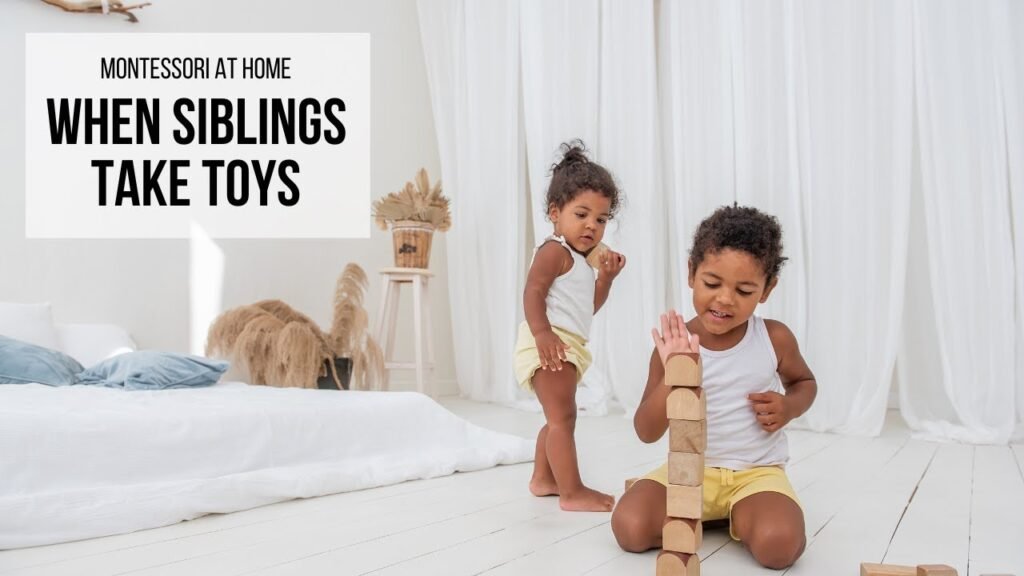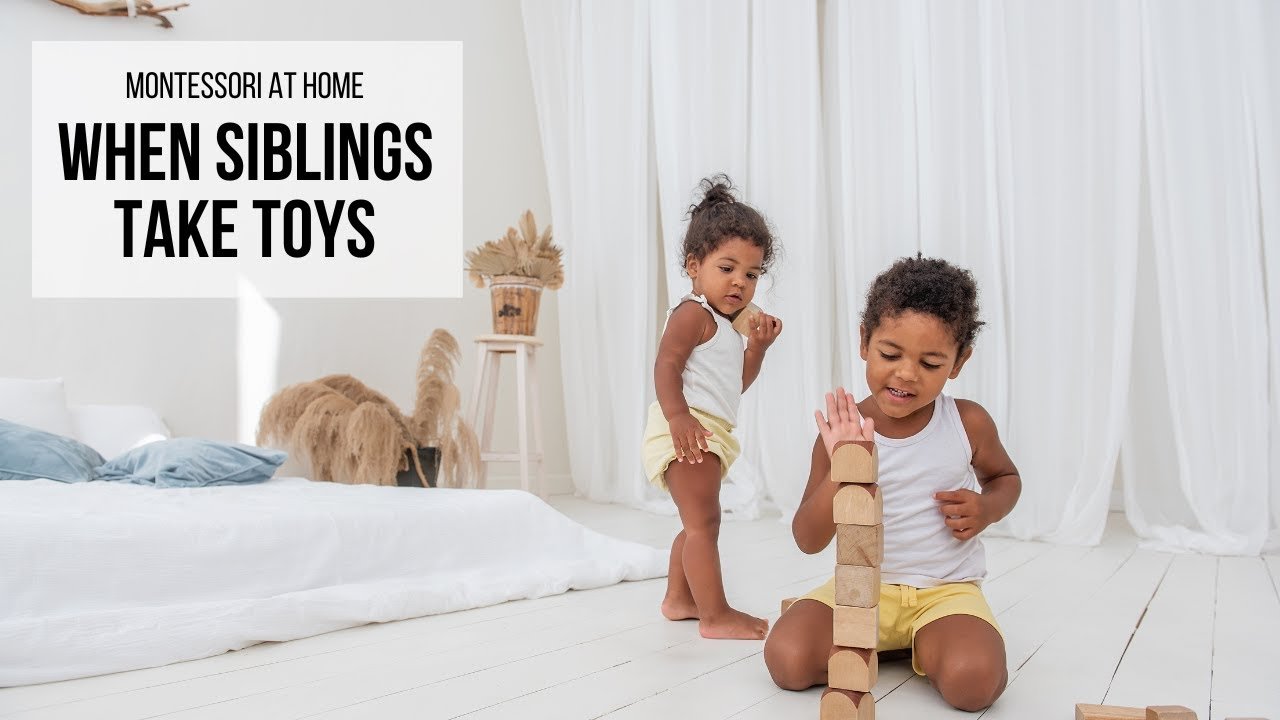In the video titled “Montessori at Home: When Siblings Take Toys” by Hapa Family, Ashley, a mother of two girls, shares her struggles in handling her children’s conflicts over toys. She describes her son as observant and sensitive, while her daughter is adventurous and mischievous. Despite trying various strategies like redirecting and offering alternative activities, Ashley admits to feeling stuck and frustrated in finding a solution. She seeks help in understanding her daughter’s behavior and wants tools to empower both of her children as they navigate life as siblings.
As a parent, it’s important to recognize that this behavior is typical for the age and common between siblings. Factors like basic needs, personality differences, and age gaps can contribute to the behavior. To promote positive sibling relationships, it’s crucial to focus on tools and strategies that allow the children to solve problems on their own. For younger toddlers, a “wait and see” approach may be best, while older toddlers and preschoolers can benefit from strategies like physical proximity, sportscasting, and setting limits. Providing separate spaces, utilizing nap time for independent play, and coaching children on how to handle toy-taking situations can also be helpful.
Understanding the Situation
Parent’s question about siblings fighting over toys
Lauren, a parent from Phoenix, Arizona, has reached out for advice on how to handle her two children, a three-year-old son and a 17-month-old daughter, who constantly fight over toys. She is seeking guidance on how to set boundaries and promote positive sibling relationships.
Description of the children’s personalities
Lauren describes her son, Chip, as observant and sensitive, always looking out for his sister, whom she refers to as Bean. Chip is becoming more inventive and creative in his play, showing a growing imagination. On the other hand, Bean has a big personality and a mischievous nature. She actively seeks to disrupt her brother’s play and seems to find joy in it.
Parent’s frustration and difficulties in setting boundaries
Lauren expresses her frustration and the challenges she faces in setting boundaries between her children during playtime. Despite her efforts to redirect their attention or offer alternative activities, she feels that nothing has been successful in stopping their fights over toys. She admits to feeling stuck, frustrated, and discouraged in finding a solution.
Parent’s acknowledgement of own shortcomings
Ashley acknowledges her own shortcomings as a parent, confessing to losing patience and reacting negatively at times. She recognizes the need for improvement in her own parenting approach to better handle the situation.
Powerlessness felt by the son
Lauren highlights the powerlessness her son, Chip, feels when trying to defend himself against his sister’s behavior. Despite her attempts to teach Chip communication skills, she feels that Bean does not care and is unfazed by consequences.
Daughter’s lack of responsiveness to consequences
Lauren expresses her frustration with Bean’s lack of responsiveness to consequences. She shares her efforts to explain to both children that snatching toys is not acceptable and encourages them to ask for a turn instead. However, Bean continues to disregard boundaries and take pleasure in snatching toys from her brother.
Understanding the Behavior
Age-appropriate behavior for the daughter
Lauren acknowledges that Bean’s behavior, although frustrating, is typical for her age. As a 17-month-old, Bean is still learning about the world and engaging in parallel play, where she plays near Chip but doesn’t fully understand how to play together constructively. Lauren understands that this behavior is part of Bean’s developmental process.
Possible causes for the behavior (hunger, tiredness, overstimulation)
Lauren suggests that Bean’s behavior could be influenced by basic needs such as hunger, tiredness, or overstimulation. Addressing these needs may help reduce her impulsive behavior.
Influence of personality and age differences
Lauren recognizes that personality differences and age gaps may contribute to the behavior between her children. Chip, at three years old, may be more advanced in his social and play skills compared to Bean, who is still learning how to navigate social interactions with other children.
Avoiding competition between siblings
Lauren emphasizes the importance of avoiding competition between her children. Instead, she aims to foster a positive sibling relationship by focusing on building a bond and encouraging cooperation and teamwork.

Promoting Positive Sibling Relationships
Focusing on building a positive sibling bond
Lauren understands the significance of building a positive sibling bond. She can achieve this by providing opportunities for her children to engage in shared play and activities that foster cooperation and togetherness.
Encouraging cooperation and teamwork
Lauren plans to nurture cooperation and teamwork between her children. She will encourage them to work together on projects, help each other, and share responsibilities to develop a sense of partnership.
Creating opportunities for shared play and activities
Lauren aims to create opportunities for her children to engage in shared play and activities. This can include setting aside specific times for them to play together, ensuring they have access to toys and materials that facilitate cooperation, and creating a positive and inclusive play environment.
Celebrating and reinforcing positive sibling interactions
Lauren recognizes the importance of reinforcing positive sibling interactions. She will celebrate and praise her children when they engage in cooperative play, exhibit kindness and consideration towards each other, and make positive efforts to resolve conflicts peacefully.
Allowing for Independent Problem-Solving
Providing tools and strategies for children to solve conflicts
Lauren plans to equip her children with tools and strategies to handle conflicts independently. This includes teaching them effective communication skills, problem-solving techniques, and negotiation strategies.
Encouraging communication and negotiation skills
Lauren recognizes the value of communication and negotiation in resolving conflicts. She will encourage her children to express their feelings, listen to each other, and find mutually agreeable solutions through open and respectful dialogue.
Teaching empathy and understanding
Lauren aims to teach her children empathy and understanding. By fostering a sense of compassion and helping them develop an understanding of each other’s perspectives, she hopes to promote empathy and encourage more considerate behavior.
Avoiding constant intervention and stepping in only when necessary
Lauren understands the importance of allowing her children to independently handle conflicts. She plans to minimize constant intervention and will step in only when necessary, prioritizing their growth and development in conflict resolution skills.
Instilling confidence in the children’s abilities to resolve conflicts
Lauren intends to instill confidence in her children’s abilities to resolve conflicts. By providing guidance, support, and reaffirmation, she will empower them to trust in their capabilities and develop their problem-solving skills.
Strategies for Infants and Younger Toddlers
Using a ‘wait and see’ approach
For infants and younger toddlers like Bean, Lauren plans to use a ‘wait and see’ approach. Instead of intervening immediately, she will observe the situation and assess whether intervention is necessary or if the situation can resolve itself.
Observing the situation and assessing if intervention is needed
Lauren will carefully observe the interactions between her children and assess the severity of conflicts. By assessing the situation, she can determine if intervention is necessary to ensure their safety or if the children can work out the issue on their own.
Ensuring basic needs are met (hunger, tiredness, overstimulation)
Lauren recognizes the importance of meeting her children’s basic needs. She will ensure they are well-rested, fed, and not overstimulated, as these factors can contribute to impulsive behavior and conflicts.
Strategies for Older Toddlers and Preschoolers
Using physical proximity as a deterrent
Lauren plans to use physical proximity as a strategy to prevent conflicts between her children. By staying physically close and monitoring their play, she can intervene or redirect their attention before conflicts escalate.
Sportscasting to verbalize and address the behavior
Lauren will use sportscasting as a technique to address the behavior. By verbally describing the situation and their actions, she can help her children understand how their behavior affects others and provide guidance on more appropriate ways to interact.
Setting clear limits and expectations
Lauren intends to set clear limits and expectations for her children’s behavior. By clearly communicating what is acceptable and unacceptable, she can provide a framework for appropriate play and guide her children to make better choices.
Teaching problem-solving and conflict resolution skills
Lauren plans to focus on teaching her children problem-solving and conflict resolution skills. She will provide opportunities for them to practice finding solutions together and encourage them to use these skills independently.
Consistently reinforcing positive behavior
Lauren recognizes the importance of reinforcing positive behavior consistently. By praising her children when they exhibit positive behavior and rewarding their efforts to cooperate, she can encourage more desirable conduct.
Proactive Strategies
Providing separate space for older child’s special projects
To avoid conflicts over special projects or toys, Lauren will create separate spaces for her older child, Chip. This will give him a designated area where he can work without the fear of his sister taking his belongings.
Utilizing nap time as an opportunity for independent play
During her younger daughter’s nap time, Lauren plans to utilize this opportunity for independent play with her older son. This uninterrupted playtime can help reduce conflicts and provide him with focused attention.
Coaching the child on how to handle toy-taking situations
Lauren intends to coach her children on effective ways to handle toy-taking situations. By teaching Chip to assertively communicate his needs and encouraging Bean to wait or find alternative activities, she can guide them towards more positive behavior.
Creating a structured routine with designated play times
Lauren believes that establishing a structured routine with designated play times can help reduce conflicts over toys. By including specific play periods for both children, they can anticipate and enjoy their individual playtime while minimizing tension.
Conclusion
Lauren’s question and concerns about her children fighting over toys are relatable experiences shared by many parents. Understanding the behaviors, addressing underlying causes, and promoting positive sibling relationships are key to finding solutions. By allowing for independent problem-solving, implementing strategies specific to each age group, and taking proactive approaches, Lauren can create a more harmonious environment for her children. With patience, consistency, and a focus on fostering positive sibling interactions, Lauren can navigate this challenging phase and support her children in developing valuable skills for future relationships.

